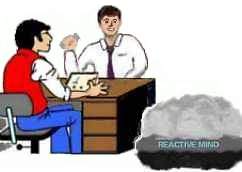Cause of ARC Breaks |
||||||||||||
|
The reason for ARC breaks in auditing can be stated
to have one common source: Rule 2: To turn off an ARC break, you have to find and indicate the correct By-passed Charge. Charge can be bypassed in a number of ways. It gets restimulated by life or it gets restimulated and not picked up in auditing. You can make up a list of all the types of charge that can be bypassed and all the principal ways this can happen and you will have a Repair List. (Also called a Correction List or Prepared List). In ST there exists a great number of repair lists; each is designed to pick up the different types of BPC that can come about from one particular type of auditing. By doing the list the auditor can find it and handle this particular area. Charge can of course also be by-passed by life itself. Have you ever seen a person who was extremely upset because some little thing that happened to him in life? That upset was technically speaking caused by By-passed Charge. To turn off that ARC break all you have to do is to find and indicate the correct By-passed Charge.
If you had a very upset or bogged (in trouble) pc, you would simply take the right list, read the whole list to him and tell him which line gave the most reaction and he would experience considerable relief. That is what rule 2 means: Find and indicate the correct BPC. The action described is called an ARC break Assessment. Example: Let's say we have a very upset woman. She was upset due to things that happened at work. A list that covers all types of By-passed Charge on a person in this situation would be the L1C. (it is designed to handle ARC Broken, sad, hopeless or nattery pc's). So we take the woman and put her on the cans. We instruct her by saying she does not have to say anything, but just listen to the questions and statements we are going to read to her. We read the first question and quickly note down the Meter reaction on it; then we go on to the next line without expecting or asking for an answer. This way we go through the whole list. When we have finished the list we look it over quickly to see which line gave the most reaction. We find the line: "Has a reality been refused?" gave the biggest read, a Blowdown from 3.1 to 2.9. We have located the main By-passed Charge - or so we hope. We simply tell the pc: "I want to indicate a reality had been refused!" We see her brighten up and feel a lot better. There is an additional BD on the Meter - from 2.9 to 2.5. She begins to tell some details about the upset. There is an F/N. OK, that tells us clearly it was a correct charge indicated. We wouldn't necessary have to know what reality had been refused or do anything further with it. The indication alone would cause a significant improvement in the pc's condition right away. That is what is meant by find and indicating the correct By-passed Charge. The action of locating the main By-passed Charge is an ARC break Assessment. It is not classified as auditing the pc as any communication is held to an absolute minimum. It is described to be between the Meter and the pc's Bank. Assessment is defined this way: "It is
the action done from a prepared list. Assessment is done by the auditor
between the pc's Bank and the Meter. The auditor reads each line from the
list and notes which line or item has the biggest reaction. The auditor
looks at the Meter while doing an Assessment. Assessment is the action of
obtaining a significant item from a pc." It is of course the same principle we use when handling the ARC break rudiment. There we would do two quick Assessments. First we would find the ARC break incident. Then we would do the Assessment: "Was it a break in Affinity?, Reality?,
Communication?, Understanding?" (ARCU).
The BPC - It's Earlier
One key to understanding the nature of BPC is "Earlier". It is some incident or charge earlier in time that gets keyed in or reactivated. The cause of something is always earlier than the resulting effect. This incident or charge is unknown to the pc. It enforces its reactive content upon the pc and he dramatizes it. He can be in pain, agony, in a rage or grief as a result. When the correct type of charge is found with a Meter and indicated the pc's upset will immediately cool off. That does not mean that you in most cases wouldn't do more about it. The various repair lists have usually detailed instructions how to clean up the charge further. But in case of extremely upset or troubled pc's you would simply assess all the way through the list and indicate the largest read and the pc will cool off. He will settle down and collect himself to a point where a real communication can be established and now you can start to audit him.
It was restimulated, but not picked up
Example from life: A man wants to start a relationship with a woman he finds very attractive. He asks her to meet him at a restaurant in another city, where she lives, for a romantic date. She agrees with delight, it seems. He goes through all the preparations to look his best, buy flowers and so on and he is there exactly at the appointed time after going through hell and high waters. She never turns up. She doesn't call or give him any explanation. In such a case he would most certainly get upset. She turned on a switch. She gave him great hopes and expectations and then it came to nothing! Maybe she did call him the next day and told him, that her mother had just died. He would tend to relax and feel some relief. If it was true, the whole matter could go away and they would meet and establish a good relationship. Let's say it was a lie, a false excuse. Then he would get really upset and end any possibility of a relationship. She had given a wrong indication: It was a lie. The whole incident had restimulated all kinds of things in his Bank: earlier lies, earlier times a relationship failed, earlier times somebody let him down, even the death of his own mother. He wouldn't necessarily remember all these incidents, but they would kick in and be the real reason for his extended misery and his extreme upset. It was "Earlier reactive charge restimulated, but not seen" = BPC.
BPC and Auditing The point here is however, that the expectations of finding something charged makes the Bank come alive. The switch is turned on. If the auditor ran all kinds of processes and had no TA on any of them the pc would also get upset eventually. Because the auditor never found any of the things the questions called for. Examples from Auditing: Let us give some examples of BPC in session:
Example 1: The auditor asks for a painful incident. The pc tells him about a car accident. The auditor doesn't acknowledge the pc's answer, but changes his mind about what he wants the pc to look for. (Q & A). The lack of follow-through and the absence of even an ack mean that the auditor didn't end cycle on the charge restimulated. Also, his question actually restimulated a number of painful incidents that the pc is now stuck with. That is an illustration of the importance of completing cycles and having a good auditing comm cycle. In the absence of this the pc will frequently ARC break. In terms of M/W/H the pc is made to have an inadvertent missed withhold. Example 2: The pc is on a Chain of incidents and have just finished telling the auditor about what happened when she was 3 years old. The auditor asks for an earlier similar incident. The pc can't find any, because she is convinced of that "nobody can remember incidents before the age of 3". The auditor accepts that and the pc ARC breaks. (The same can happen if the pc refuses to go earlier than this life).
In cases like this incidents and reactive charge unknown to the pc and auditor kicks in as BPC and causes an ARC break. Overlooking an incident later in time does not cause the same kind of trouble. It is the earlier charge that kicks in as BPC. Example 3. Auditor takes up flying rudiments related to "Trouble with your hip". The pc finds things to run, but then suddenly ARC breaks. Her real trouble was not with the hip, but trouble with her back. Running something close to this and possibly related, but not running the thing that pc has her main attention on, causes the session to go astray.
The charge stemming from her back troubles is being
by-passed = BPC. Situations like this are usually caused by inability to
read the Meter correctly. The auditor overlooked the BD on 'back' and took
up the SF on 'hip'.
Example 5. You are pulling a Chain of withholds on a man that went to war. The pc can't bring himself to tell all the terrible things he did in battle but tells a more acceptable version of the events and how it wasn't really his fault. The auditor is buying it. At some point the pc blows up. The BPC is from what he really did. Getting all the terrible details handles the situation and saves the pc and session.
These examples cover some typical situations. Over the years a great number of situations have happened in all kinds of auditing actions. The odds for avoiding BPC in session are much better when the auditor has a smooth comm cycle (TR's), is better at reading and handling the Meter, and has a better understanding of the mind and the pc. But from all this important lessons were learned. The items and questions on the Repair Lists were added to and revised repeatedly until they were designed to detect and handle any type of situation and BPC that could occur for a certain action. These lists are valuable tools you can add to your auditor's tool box here on Level 3. You are ready to be armed so you can handle any dragon or monster you can run into in auditing or life.
|
||||||||||||

















